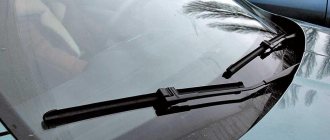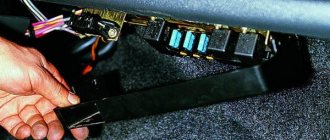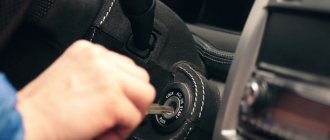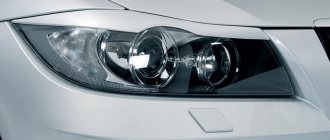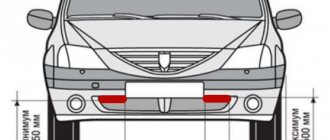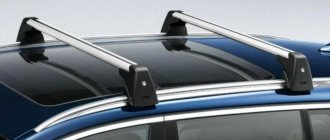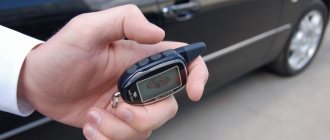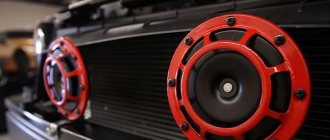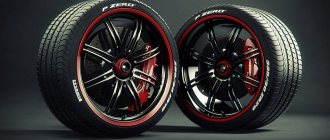Once every three or five years, a car owner faces the important question of choosing a new battery.
Almost all manufacturers guarantee that their products will faithfully serve the user for 7 to 10 years.
In fact, under ideal operating conditions, the battery will need to be replaced much earlier.
Technicians do not stop there and develop new technologies, methods and equipment (for example, hybrid batteries).
What is it, a hybrid battery?
The word “hybrid” itself means the use of a pair or several technological solutions in obtaining a product.
The hybrid battery was developed by combining two equipment manufacturing technologies, which include a crossed composition of the electrolyte properties of such unique substances as calcium and antimony.
A hybrid battery consists of two types of plates. Some are made on the basis of a lead-antimony alloy, others are made on a lead-calcium alloy. To distinguish a regular battery from a hybrid one, you should look at its markings.
The hybrid battery has the inscription Calcium Plus or Ca+ on its body.
Description of hybrid battery technology
The developers chose the advantages of two technologies, combined them and got a new one - a hybrid one.
Thus, the best of calcium and antimony batteries are ideally combined in a hybrid battery. Plates made from a lead-antimony alloy have a positive charge, while lead-calcium plates have a negative charge.
The use of low-temperature calcium in obtaining the required alloy ensures that the finished product, in this case the gratings, is corrosion resistant.
In a hybrid battery, calcium helps reduce the level of electrolyte evaporation and prevents self-discharge of the battery. Antimony in the grid guarantees high resistance to complete discharge.
What it is
First you need to understand what the concept of a hybrid battery means.
These are batteries whose production uses 2 technologies.
Hybrid batteries are those in which the positive plates are made using low-antimony technology, and the negative plates are made using calcium technology.
Due to this, the hybrid receives higher starting current and also becomes less susceptible to discharge.
A common mistake is to call hybrid batteries calcium. In fact, there is a separate concept of calcium batteries. This is a newer and more advanced technology that makes a completely calcium-based battery maintenance-free.
But hybrid batteries, which, although they encounter significantly lower volumes of water evaporation, still remain serviceable. They are usually called low-maintenance.
Hybrid batteries have screw-on caps, when opened, you can add distilled water inside the cans and check the density of the electrolyte and its level.
What is the difference between low-antimony and calcium batteries?
The chemical element called “lead” is quite soft in its properties, therefore, it is not very effective when used alone.
Adding antimony to it will give the plate the required strength. The disadvantage may be boiling of the electrolyte solution, which leads to unwanted evaporation.
This means that you need to regularly add distilled water to the jars.
If the plate contains more than 5% antimony, it is an old model (an improved design has a reduced amount of antimony).
Batteries with low antimony content are low maintenance. The main difference between low-antimony and hybrid devices is the level of evaporation.
The introduction of Ca into a lead-containing lattice instead of antimony is a new direction in the evolutionary development of the battery. It is also known to add a small amount of Ag.
Batteries with Ca-containing plates have a low level of electrolyte evaporation. There are sealed, completely maintenance-free models that have increased capacity and efficiency.
The calcium component ensures low self-discharge of the hybrid battery, as well as the use of a thinner lead grid. They are distinguished by their resistance to complete discharge (which the antimony battery shares with them).
Features of the device and principle of operation
Hybrid battery device.
The design of any car battery involves six “cans”, which are assembled from lead plates. Their polarity alternates. The “cans” float in electrolyte – a conductive liquid, and are themselves placed in a housing. On the surface of the latter there may be holes for removing gases, as well as a neck for adding liquid (if the battery is of a serviceable type). When a lead battery is discharged, lead sulfate is deposited on its plates, and the electrolyte is “transformed” into water. During charging, the sulfate binds with the hydrogen of water, and a conductive medium is obtained.
Previously, antimony batteries were popular, where the plates contained 5% antimony. Antimony improves resistance to rust and mechanical stress. But such products had a high degree of self-discharge, and they also had to add water from time to time. In antimony batteries currently produced, the antimony content is 2.5 - 3%, and the negative properties are partially reduced.
Calcium batteries are made from plates that contain up to 0.1% Ca. This significantly reduces self-discharge and water consumption. But the weak point of such batteries is deep discharges. Five is enough (for antimony ones - 30) for the battery to deteriorate.
Hybrid batteries are somewhere in between. By combining technologies, these products are less demanding to maintain and at the same time resistant to deep discharge. Hybrid class batteries are also called “low maintenance”.
Hybrid batteries are characterized by high starting currents, which makes it easy to start the engine even in cold weather. Subject to compliance with operating rules, their service life reaches 10 years.
Advantages and disadvantages
Hybrid batteries have significantly more advantages than disadvantages:
- Not only the consumption of the solution is reduced, but also its boiling point.
- Minimal risk of self-discharge.
- High starting current. High efficiency is achieved due to lead-calcium negative electrons. The plates are treated with a special method that prevents oxidative processes and also increases current output.
- Increased resistance to full discharges is ensured by a positive electrode based on lead and antimony.
- The hybrid battery starts easily in winter due to cold cranking current.
Among the shortcomings, only a few facts can be highlighted:
- In hot weather, the user will still have to pour distilled water into the battery.
- A relatively low-antimony hybrid battery is more expensive.
- Fraudsters often choose this equipment for counterfeiting (you need to choose it at specialized retail outlets).
Summer and hybrid battery
Modern car alternators put out many more volts than older models, especially on electronics-laden models. In summer, the battery does not receive “cold starts”, which is why it spends less energy to start and recharges faster. And if it receives a high voltage, it will begin to boil, and the water from the electrolyte evaporates, the amount of acid increases, the plates heat up and become exposed, this leads to shedding of the active mass. For this reason, it is necessary to check the hybrid battery once a month.
Hybrid battery service
Servicing of a low-maintenance battery is required once a quarter.
To do this, you need to remove the cover, measure the level and density of the electrolyte. If the level is low, then 0.5 liters of distilled water must be added to the electrolyte. A preventive inspection, carried out periodically, will make it possible to prevent any problems with the performance of the battery.
Level control can be carried out visually using a special mark on the body (or on some, the manufacturer installs indicators).
Servicing also includes cleaning of white deposits that contain lead sulfate. It is formed by the chemical interaction of reagents.
Popular models
There are plenty of battery manufacturers, and many have Hybrid lines. Among the popular models it is worth highlighting:
- Bosch S5 005. Battery from a German manufacturer, with a protective cover and a handle for transportation. The body is made of impact-resistant plastic. The performance properties are optimal for operation in metropolitan conditions. Capacity – 63 Ah. Starting current – 610 A;
- Energizer Premium EM60LB2. American protected battery, made using Stamped Grid technology - with more durable grids. Capacity – 60 Ah. Starting current – 540 A;
BEAST 66L 640A. - AlphaLine AGM (SA 59520/AX 595950). A model from a South Korean manufacturer, made using AGM technology - the electrolyte is not in the usual liquid state, but in the form of impregnation. Features: for cars with a Start-Stop system, high energy intensity, minimal self-discharge during storage. Capacity – 95 Ah. Starting current – 850 A;
- BEAST 66L 640A. Manufacturer – Russia. This model is designed for operation in difficult weather conditions. Capacity – 66 Ah. Starting current – 640 A.
Among the manufacturers are: “Battery Technologies”, “Alcor”, “Tyumen Bear”, “A-Mega”, “AKTEX”, “Orion”, “Black Horse”, “TAB”, “Varta”, “Zubr” and etc.
Hybrid batteries are easy to maintain and durable power sources, which in terms of performance parameters are similar to calcium and low-antimony batteries, being something in between. Their capacity is increased, as is their resistance to deep discharge, and if adding water to the battery once a quarter is not a problem, then a hybrid battery will be an excellent choice.
Operating period
Like any product, a hybrid battery has a production date and service life.
Ideally, you should buy equipment that was released two or three months before purchase. Of course, you can choose an “older” one, but it is not advisable. Such a device, with regular maintenance, can last, as the manufacturer promises, up to 7 years.
To increase service life and maintain functionality, the correct solution would be to check the level and density of the electrolyte, and timely clean the grid of sulfate deposits.
A-Mega Ultra/Premium
The products of the Ukrainian battery manufacturer also deserve to be included in the ranking of the best hybrid batteries for passenger cars. In particular, two series of batteries are produced using combined technology - Ultra (on the Russian market their cost starts at 5,000 rubles, and this is one of the most profitable offers), and Premium (from 11,000 rubles). The service life declared by the manufacturer is 6 years.
Among the features of the A-Mega hybrid lines, we note a 12-fold reduction in electrolyte losses and increased vibration resistance of batteries. It should also be noted that the ability to ensure engine starting in frosts down to -30 degrees, thanks to the use of vertical grating cores, it was possible to significantly reduce the current resistance.
Selecting a charger
The wrong choice, charger connection or charging duration is a very important decision that can negatively affect the functionality of the battery:
- The optimal charger voltage ranges from 13.8 to 14.2 V.
- The power of the battery determines the power of the required charger. The maximum charge current depends on the battery capacity, which is determined by the manufacturer.
- The charger must have an adjustable output voltage.
- The reliable charger is equipped with an electric current power limiter.
- Automatic chargers that block the charging process in case of incorrect connection, as well as protect against power surges, are considered universal and very easy to use.
How to choose a memory
In order to avoid problems with recharging the power source, you should be responsible when selecting a charger:
- The charger should produce the optimal voltage for recharging - 13.8-14.2 V.
- The requirements for the maximum current output, which determines the charging time, are determined by the battery capacity specified by the manufacturer. Powerful charger will charge a more powerful battery.
- The charger must provide for step-by-step adjustment of the output voltage.
- The transformer device must be equipped with a maximum current limiter.
- It is best to purchase a model with an automatic control unit to avoid setup errors.
- Ideally, the charger can block the charging process if the terminals are connected incorrectly and have protection against voltage surges in the network.
Rechargeable charger options charge the battery for a long time, but sparingly. Start-charging models operate in accelerated mode and have a quick recovery function. They carry out desulfation and restore the factory capacity of the battery.
How to charge a hybrid battery
It is recommended to carry out the charging process by first checking the density of the electrolyte solution.
So, before charging, either the density (to 1.221.22 g/cm3) or the voltage must be reduced to 12 V. Preparation process:
- clean the hybrid battery from dirt;
- open the lid and “release” the gases formed from the boiling of the electrolyte;
- if the liquid level is low, add distilled water;
- connect the charger through the terminals;
- connect transformer power.
After 2 hours, control of just a few indicators:
- the current must be 10% of the battery capacity, and the voltage cannot exceed 14.2 V;
- the density and temperature of the electrolyte solution is not higher than +45 C/
A charged battery has a voltage of 14.2 V and a current of 0.5 A. The user will see bubbles.
After charging, check the electrolyte levels in each jar, add water if necessary and close everything.
Proper Maintenance
Hybrid battery options are becoming popular.
And this even despite their high price. This is because the battery is not too difficult to maintain and has a longer service life. The hybrid battery requires special care during the summer. During these hot months, water will begin to boil away from the electrolyte as much as possible. To prevent the battery from deteriorating, it is necessary to frequently check the level of the solution and its density. We recommend: Operating the bosch s5 silver plus battery
Usually special marks are installed in the battery, which make it easy to monitor the electrolyte. Some devices also have special indicators. If the acid level drops, distilled water must be added. The hybrid must be thoroughly cleaned if lead sulfate begins to form on the plates. This is a white coating.
Battery desulfation
Over time, any battery will begin the process of sulfation. This is because the electrolyte and lead form a reaction. But if you choose the wrong acidity, this process will speed up. This is why it is necessary to use desulfation correctly. This process efficiently purifies lead sulfates. To carry out the procedure correctly, you need to use several methods:
- Perform weak and short charges and discharges.
- Use a special chemical solution that is placed in a jar.
- Completely disassemble the battery and clean it yourself.
The last method must be done very carefully. If you have no experience in disassembling the battery, then you should avoid using this option. To carry out desulfation, a charging mechanism must be used. The charger screen will display all information about the installed capacity. If you don’t have a special device at home, you can take a simple charger that has the ability to set ampere and volt.
Correct charging and discharging:
- First you need to check the electrolyte level inside the battery. If the indicator is low, then distilled water is added inside the device.
- The equipment is supplied with a voltage of 14.2 volts with a current of 1 ampere. The battery is connected to the charger.
- It is necessary to leave the battery in this position overnight. The voltage should increase to 10 volts.
- You should leave the battery without charging for a day. After this, we increase the current to 2.5 and charge for another 8 hours.
- The density should increase to 1.12 g per cubic centimeter. And the voltage will increase to 12.8 volts.
- To start desulfation, it is necessary to produce a powerful discharge. For example, you can use a high beam lamp. You should leave it like this for 8 hours and make sure that the reading drops to 9 volts.
- After this, the cycle must be repeated. Low current is used first. The battery is left overnight without charging, and then the device is charged with a powerful current and discharged.
We recommend: Description of the Vesta car battery series
The desulfation operation will be successful when the density is 1.27 g per cubic centimeter. The entire process takes approximately 2 weeks, but after this period the hybrid battery can be used again.
Charging Features
The hybrid does not need to be charged cyclically, like the calcium version. But you need to know how to properly charge. Certain features must be taken into account:
- In order for charging to occur as quickly as possible, it is necessary to use a powerful current - one tenth of the battery capacity. Direct current is not recommended.
- If there is absolutely no time, then the current can be set to 2 amperes with a voltage of 14.2 volts.
If you use the second method of charging the battery, you can increase the period of trouble-free operation.
Restoring a hybrid battery
The hybrid battery can be restored if there are a couple of faults:
- in order to eliminate the consequences of shorting the plate, you need to rinse the battery with distilled water until the carbon particles disappear;
- in order to reduce the sulfation of the plates, it is necessary to either pour special chemicals or connect a weak charge-discharge;
- You can get rid of sulfites by manual cleaning, but without experience you should not do this, as you can damage the plates, and therefore the entire battery.
When special solutions are used to combat sulfite deposits, the technique consists of pouring the solution and keeping it in the battery for two days.
If the battery is frozen, there is no point in restoring it. Outwardly, it looks like this: swelling of the sides, boiling of the electrolyte liquid, or shorting of the plates.
A battery that has been given a huge charge of current is considered non-renewable. This factor must be taken into account when charging the battery. You should only choose an adjustable charger.
When is the best time to use hybrid batteries?
Professionals believe that hybrid batteries should be installed on cars with a mileage of more than 150,000 kilometers or that do not have a power-off function when setting the alarm. This is due to the fact that when fully discharged, the hybrid battery recovers better and is less susceptible to sulfation. This type of battery is well suited for those countries where the frost in winter is over thirty degrees Celsius, and in summer there is moderate heat. Manufacturers do not recommend installing hybrid batteries in modern cars, as they require more attention. Moreover, you should not purchase such a battery for a car in which the battery is located in the passenger compartment or in the trunk, since a person will have to inhale vapors of distilled water, which does not have a very good effect on the body.

